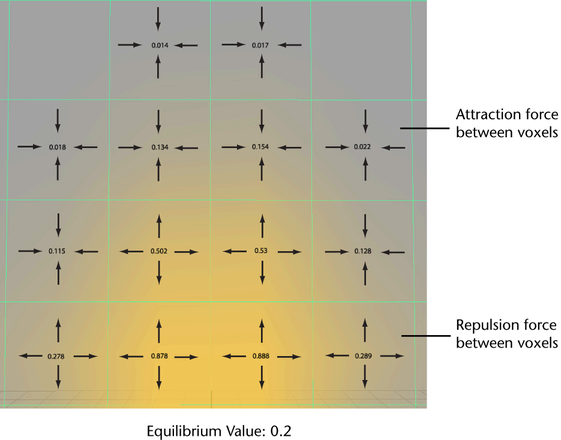You can modify the behavior of a dynamic fluid simulation by applying forces to the fluid. You can use forces that are built into the fluid (most efficient method), or external forces (fields).
You can also use Self Attraction and Repulsion attributes to generate forces that affects the behavior of your fluid. See Using self attraction and repulsion forces.
Using forces built into the fluid
Using the forces built into the fluid is an efficient way to modify the way dynamic fluids move. Because they are built into the fluid, they compute more quickly than forces applied externally.
Density and Velocity must be set to Dynamic Grid to use the internal forces.
You can modify Gravity and Friction forces acting on the fluid in the Dynamic Simulation section of the fluidShape Attribute Editor. See Gravity and Friction.
Density and Temperature both have Buoyancy attributes you can modify in the Contents Details section of the Attribute Editor. See Density, Temperature, and Buoyancy.
In the Contents Details section you can also add Turbulence, and Velocity swirl and damping. See Turbulence and Velocity.
Using fluid Velocity as a force
Velocity can be used as a force to move values around in the dynamic grid. The velocity Swirl attribute built into the fluid is particularly useful for creating swirl motion in small grids. See Velocity.
Using self attraction and repulsion forces

Using Self Attraction and Repulsion attributes, you can generate attractive and repulsive forces between voxels in 2D or 3D fluid containers. A Self Force attribute sets whether the force is determined by the container's Density or Temperature grid. See Self Force.
The Equilibrium Value attribute determines whether voxels generate an attractive force or repulsive force based on the grid's raw density or temperature value.
For example, if you set Self Force to Density, and the Equilibrium Value to 0.2, voxels that have a current density of less than 0.2 pull density from surrounding voxels, while voxels with a current density greater than 0.2 push density into surrounding voxels. Voxels with a current density of 0.2 are in a state of equilibrium and do not generate a force. See Equilibrium Value.

This means that as emitted density passes through a voxel and then dissipates, its Self Force changes from attraction to repulsion or from repulsion to attraction, depending on the changes in density. Scaling values, such as Density Scale, do not affect the voxel's self force. The Self Attract and Self Repel attributes set the strength of the self force. See Self Attract and Self Repel.
Maya Fluid Effects creates incompressible fluids. The amount of incompressibility is set by the Solver Quality attribute. Self attraction and self repulsion forces must work against the fluid's incompressibility to either push or pull neighboring voxels. To see the full effects of Self Attract and Self Repel in your fluid effect, you must make the fluid more compressible by setting the Solver Quality attribute to a low value. Turning on Forward Advection can also increase the fluid object’s compressibility, making the effects of Self Attract and Self Repel forces more noticeable.

Changing the fluid's solver attributes can affect the simulation results of your fluid effects. For example, you can turn on High Quality Solve to make fluid simulations appear much more detailed without increasing resolution. You can increase the Substeps or Solver Quality to increase the accuracy of the simulation. You can also change how Density, Temperature, and Fuel grids are solved by turning on Forward Advection. Fluid solver settings are accessed from the Dynamic Simulation section of the fluidShape node Attribute Editor.